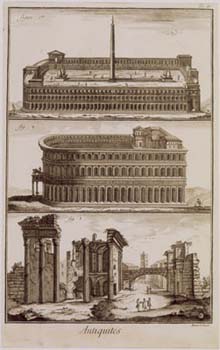Antiquités, Planche IV (Antiquities, Plate IV), from Encyclopédie of Denis Diderot and Jean d'Alembert
- 1751-1772
- Robert Benard (French b. 1734, fl. 1750-1785)
- Engraving
35.8 x 22.8 cm., 14-2/16 x 9" image
- Catherine Carter Goebel, Paul A. Anderson Chair in the Arts Purchase with Gift of Elizabeth and John Ducey, Paul A. Anderson Art History Collection, Augustana College 2001.35.k

Essay by Jeffrey Weiland, Katie Otter, Andrea Ritche, Class of 2008
The Encyclopédie, edited by Denis Diderot and Jean d'Alembert, was developed by a large variety of contributors from many different backgrounds, from doctors and priests to nobility and merchants. Containing 72,000 articles, it represents one of the most important historical artifacts toward technology education (Wernick 72-80). The Encyclopédie, with its detailed illustrations of the mechanical arts, allowed industrial knowledge to be available to many people. This created a potential shift towards a liberal economic strength based more on the individual's self-interest. It also created a shift that minimized the amount of control the state and government had on industrial aspects. This particular plate (48A), engraved on laid paper, introduced a jack mechanism used for lifting marble blocks (L'operation d'elever un bloc de marbre, & outils) (ARTFL Project).
Featured at the top of the plate is a diagram (top Figures 1-5) that illustrates a situation where this tool would most commonly be used. At the bottom of the plate (Figures 1-4), the tool is depicted in four different views in order to communicate its constructive attributes. The contributors to the Encyclopédie developed an accurate integrated language that could be digested by the largest variety of people and paved the way towards approaches used in modern education.
The Encyclopédie reflected the basic philosophy of the European Enlightenment and the growing interest in intellectual pursuits, especially in the arts and sciences which are referenced within. The point of this work was to summarize contemporary knowledge and offer people a new way to look at the world. It was written by more than 140 contributors, many of them the great thinkers of the Enlightenment, with some of the more famous names being Jean-Jacques Rousseau, François-Marie Arouet de Voltaire, and Jean-François Marmontel (ARTFL).
Antiquitiés Planche IV (48B), engraved by Robert Benard, a prolific engraver who was most active during the 1770s and 1780s. Ancient architecture as is depicted on this page, Antiquitiés, was extremely influential both culturally and artistically as the modern European world looked to its enlightened past for inspiration. As Pompeii and Herculaneum were being unearthed, students completed their Grand Tour and intellectuals fawned over the grandeur of the past. The architectural wonders of Rome particularly attracted many admirers. This specific engraving depicts three ancient structures in Rome, the Circus of Caracalla (or Circus of Maxentius), the Theater of Marcellus and the Forum Nerva. (ARTFL). Such imagery inspired many enthusiasts of antiquity to take the Grand Tour and visit these sites in person in order to experience firsthand the wonders of ancient Rome.
